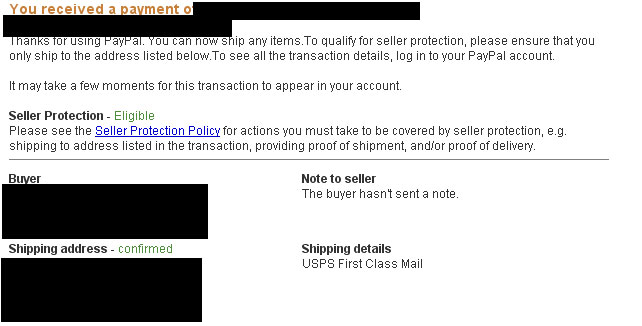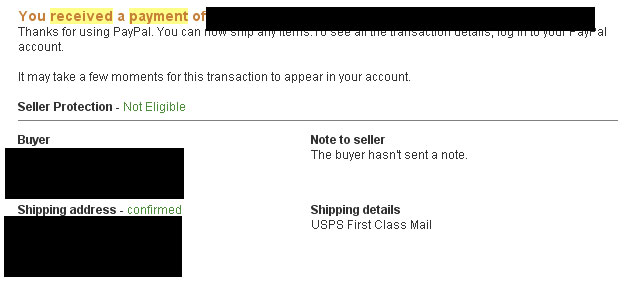Update: All of the following information is still correct, but I did do some more digging through the eBay forums and found some other people who have all been having the same problem for the last week. You can read some here. I think one thing that people are still missing is that the status is removed from the original payment if a claim is filed.
Original Post
So I noticed something odd today in my payment confirmations from PayPal for my eBay sales. PayPal offers a “Seller Protection Policy” (SPP) which guarentees transactions provided certain criteria are met with the payment, and sellers obey certain rules in shipping and fulfilling orders. I’ve only ever had to use it a few times to get back money when a buyer filed a chargeback against me that I felt was unfair. But it’s nice to know that it’s there and it provides sellers with a sense of protection.
For a long time, when you receive a payment received notification from PayPal, it would show whether or not the transaction was eligible for the SPP in that email. In the following screen shot, you can see an example of this. Click on the screenshot for a larger, clearer version. There’s a section labeled Seller Protection Policy, next to that it says Eligible, and then below it has a simple summary of the SPP. I’ve blocked out all private information in the following screenshots.
Since May 27th, I have not received a single email that showed that a transaction was eligible. I only just realized this today. In that same spot on the following email, you’ll see that it says Not Eligible next to Seller Protection Policy (again, click for a larger, clearer image):
However, if I go and look at the transaction details page inside PayPal, it shows that the transaction is Eligible. The eligibility status is in the upper right hand corner of the screen shot:
I’ve checked dozens of payments in the last hour, and in every case the email says that a transaction is Not Eligible, and the payment details page says that the transaction is eligible.
This isn’t just confusing, it’s potentially problematic for sellers who may end up in an argument with PayPal about the eligibility of a transaction for the SPP. When a chargeback or reversal is filed on a payment, PayPal removes the SPP section from the transaction details page. The entire entire “Okay to Ship!” section, with the SPP status, address and address status are all removed from the transaction details page when there is a problem with a transaction. I’ve personally seen this multiple times. All of that information is is replaced with the following very brief note:
So, in my case, if I end up with a reversal on any of these transactions, my original payment email is going to tell me that the transaction is Not Eligible for protection, and any information to the contrary will have been stripped out of the transaction page. This is deceptive and unfair to sellers.
One thing I have to note is that I’ve ended up using those original payment emails to prove to PayPal that a transaction is eligible. I’ve done this as recently as last month. I thought for a moment that perhaps there was some limit to the frequency that one could use the SPP, but after checking the official User Agreement for PayPal, not so. Section 11.2 states that, “There is no limit on the number of payments for which you can receive coverage.” So that doesn’t seem to be the case.
It’s also possible this is just a glitch in the system, it certainly wouldn’t be the first one I had seen with PayPal’s notification system.
Regardless of the reason behind this, it’s another reason that PayPal needs to stop removing the SPP status of a payment when there is a chargeback, claim or reversal filed against it. Sellers have the right to know that status.
Tags: chargeback · claim · eBay · payment · PayPal · Seller Protection Policy1 Comment - Follow the string





1 response so far ↓
I no longer have a confirmed address when sending PayPal payments. In my profile settings is shows confirmed but the email notice and eBay checkout both say unconfirmed. I assume this is another glitch but could be another possible circumventing of seller protection.